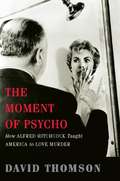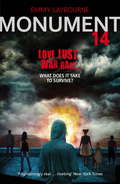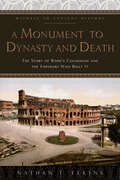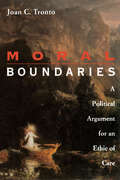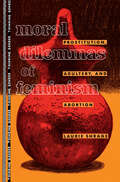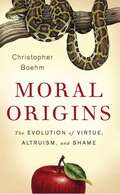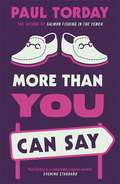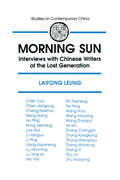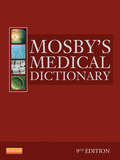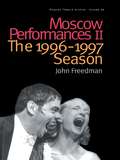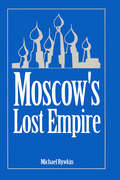- Table View
- List View
The Moment of Psycho: How Alfred Hitchcock Taught America to Love Murder
by David ThomsonIt was made like a television movie, and completed in less than three months. It killed off its star in forty minutes. There was no happy ending. And it offered the most violent scene to date in American film, punctuated by shrieking strings that seared the national consciousness. Nothing like Psycho had existed before; the movie industry—even America itself—would never be the same.In The Moment of Psycho, film critic David Thomson situates Psycho in Alfred Hitchcock&’s career, recreating the mood and time when the seminal film erupted onto film screens worldwide. Thomson shows that Psycho was not just a sensation in film: it altered the very nature of our desires. Sex, violence, and horror took on new life. Psycho, all of a sudden, represented all America wanted from a film—and, as Thomson brilliantly demonstrates, still does.
The Moment of Psycho: How Alfred Hitchcock Taught America to Love Murder
by David ThomsonIt was made like a television movie, and completed in less than three months. It killed off its star in forty minutes. There was no happy ending. And it offered the most violent scene to date in American film, punctuated by shrieking strings that seared the national consciousness. Nothing like Psycho had existed before; the movie industry -- even America itself -- would never be the same. In The Moment of Psycho, film critic David Thomson situates Psycho in Alfred Hitchcock's career, recreating the mood and time when the seminal film erupted onto film screens worldwide. Thomson shows that Psycho was not just a sensation in film: it altered the very nature of our desires. Sex, violence, and horror took on new life. Psycho, all of a sudden, represented all America wanted from a film -- and, as Thomson brilliantly demonstrates, still does.
Money and Banking
by Robert E. WrightThe financial crisis of 2007-8 has already revolutionized institutions, markets, and regulation. Wright's Money and Banking V 2.0 captures those revolutionary changes and packages them in a way that engages undergraduates enrolled in Money and Banking and Financial Institutions and Markets courses.
Money and Banking
by Robert E. WrightThe financial crisis of 2007-8 has already revolutionized institutions, markets, and regulation. Wright's Money and Banking V 2.0 captures those revolutionary changes and packages them in a way that engages undergraduates enrolled in Money and Banking and Financial Institutions and Markets courses.
Money and Banking
by Robert E. WrightThe financial crisis of 2007-8 has already revolutionized institutions, markets, and regulation. Wright's Money and Banking V 2.0 captures those revolutionary changes and packages them in a way that engages undergraduates enrolled in Money and Banking and Financial Institutions and Markets courses.
Money and Banking v 2.0
by Robert E. WrightThe financial crisis of 2007-8 has already revolutionized institutions, markets, and regulation. Wright's Money and Banking V 2.0 captures those revolutionary changes and packages them in a way that engages undergraduates enrolled in Money and Banking and Financial Institutions and Markets courses. Minimal mathematics, accessible language, and a student-oriented tone ease readers into complex subjects like money, interest rates, banking, asymmetric information, financial crises and regulation, monetary policy, monetary theory, and other standard topics. Numerous short cases, called "Stop and Think" boxes, promote internalization over memorization. Exercise drills ensure basic skills competency where appropriate. Short, snappy sections that begin with a framing question enhance readability and encourage assignment completion. The 2.0 version of this text boasts substantive revisions (additions, deletions, rearrangements) of almost every chapter based on the suggestions of many Money and Banking instructors. Some specific highlights are: Chapter 11 now contains enhanced descriptions of recent regulatory changes, including Dodd-Frank, Chapter 12 is an entirely new chapter on derivatives covering forwards, futures, options, and swaps that also including comprehensive treatment of the causes and consequences of financial crises, and Chapter 14 has updated discussions of the Federal Reserve's monetary policy tools, including paying interest on reserves, and the structure and leadership of the European Central Bank. Recent financial turmoil has increased student interest in the financial system but simultaneously threatens to create false impressions and negative attitudes. This up-to-date text by a dynamic, young author encourages students to critique the financial system without rejecting its many positive attributes. Peruse the book online now to see for yourself if this book fits the needs of your course and students.
Monitoring Building Structures
by J. MooreThere is an increasing number of buildings that require informed decisions to be made about their continued safety and serviceability. Although social and economic issues are often all-important influences, the technical issues nevertheless need to be addressed objectively, efficiently and reliably. This book shows how monitoring the physical behaviour of a structure can assist the engineer to meet these conditions when making an assessment. The book is aimed primarily at the practising engineer charged with making recommendations in respect of safety and serviceability. By the same token, it will be of value to the client specifying a brief for assessment or evaluating the report of an investigation which involves monitoring. The book will also be one of reference for those engaged in research involving monitoring, and an aid to the advanced student who needs to understand better the full-scale performance in service of building structures. The need to assess safety and serviceability may arise for a variety of reasons, ranging from problems developing in service to change of use or the introduction of innovative features at the design stage. These reasons are explored in the first chapter which establishes a philosophy by which the assessing engineer can determine appropriate courses of action. Observations and measurements which do not address the real issues are worthless but too much information which cannot be effectively digested and interpreted is also not useful.
Monument 14 (Monument 14 Ser. #Bk. 1)
by Emmy LaybourneFourteen kids stranded inside a superstore. Inside they have everything they could ever need. There's junk food and clothes, computer games and books, drugs and alcohol ... and without adult supervision they can do whatever they want.Sounds like fun? But outside the world is being ripped apart by violent storms and chemicals leaking into the atmosphere that, depending on blood type, leave victims paranoid, violent or dead. The kids must remain inside, forced to create their own community, unsure if they'll ever be able to leave. Can they stop the world they've created inside from self-destructing too?'Riveting' New York Times'A post apocalyptic wild ride' Huffington Post
A Monument to Dynasty and Death: The Story of Rome's Colosseum and the Emperors Who Built It (Witness to Ancient History)
by Nathan T. ElkinsEarly one morning in 80 CE, the Colosseum roared to life with the deafening cheers of tens of thousands of spectators as the emperor, Titus, inaugurated the new amphitheater with one hundred days of bloody spectacles. These games were much anticipated, for the new amphitheater had been under construction for a decade. Home to spectacles involving exotic beasts, elaborate executions of criminals, gladiatorial combats, and even—when flooded—small-scale naval battles, the building itself was also a marvel. Rising to a height of approximately 15 stories and occupying an area of 6 acres—more than four times the size of a modern football field—the Colosseum was the largest of all amphitheaters in the Roman Empire. In A Monument to Dynasty and Death, Nathan T. Elkins tells the story of the Colosseum's construction under Vespasian, its dedication under Titus, and further enhancements added under Domitian. The Colosseum, Elkins argues, was far more than a lavish entertainment venue: it was an ideologically charged monument to the new dynasty, its aspirations, and its achievements. A Monument to Dynasty and Death takes readers on a behind-the-scenes tour of the Colosseum from the subterranean tunnels, where elevators and cages transported gladiators and animals to the blood-soaked arena floor, to the imperial viewing box, to the amphitheater's decoration and amenities, such as fountains and an awning to shade spectators. Trained as an archaeologist, an art historian, and a historian of ancient Rome, Elkins deploys an interdisciplinary approach that draws on contemporary historical texts, inscriptions, archaeology, and visual evidence to convey the layered ideological messages communicated by the Colosseum. This engaging book is an excellent resource for classes on Roman art, architecture, history, civilization, and sport and spectacle.
A Monument to Dynasty and Death: The Story of Rome's Colosseum and the Emperors Who Built It (Witness to Ancient History)
by Nathan T. ElkinsEarly one morning in 80 CE, the Colosseum roared to life with the deafening cheers of tens of thousands of spectators as the emperor, Titus, inaugurated the new amphitheater with one hundred days of bloody spectacles. These games were much anticipated, for the new amphitheater had been under construction for a decade. Home to spectacles involving exotic beasts, elaborate executions of criminals, gladiatorial combats, and even—when flooded—small-scale naval battles, the building itself was also a marvel. Rising to a height of approximately 15 stories and occupying an area of 6 acres—more than four times the size of a modern football field—the Colosseum was the largest of all amphitheaters in the Roman Empire. In A Monument to Dynasty and Death, Nathan T. Elkins tells the story of the Colosseum's construction under Vespasian, its dedication under Titus, and further enhancements added under Domitian. The Colosseum, Elkins argues, was far more than a lavish entertainment venue: it was an ideologically charged monument to the new dynasty, its aspirations, and its achievements. A Monument to Dynasty and Death takes readers on a behind-the-scenes tour of the Colosseum from the subterranean tunnels, where elevators and cages transported gladiators and animals to the blood-soaked arena floor, to the imperial viewing box, to the amphitheater's decoration and amenities, such as fountains and an awning to shade spectators. Trained as an archaeologist, an art historian, and a historian of ancient Rome, Elkins deploys an interdisciplinary approach that draws on contemporary historical texts, inscriptions, archaeology, and visual evidence to convey the layered ideological messages communicated by the Colosseum. This engaging book is an excellent resource for classes on Roman art, architecture, history, civilization, and sport and spectacle.
Moral Boundaries: A Political Argument for an Ethic of Care
by Joan TrontoIn Moral Boundaries Joan C. Tronto provides one of the most original responses to the controversial questions surrounding women and caring. Tronto demonstrates that feminist thinkers have failed to realise the political context which has shaped their debates about care. It is her belief that care cannot be a useful moral and political concept until its traditional and ideological associations as a "women's morality" are challenged.Moral Boundaries contests the association of care with women as empirically and historically inaccurate, as well as politically unwise. In our society, members of unprivileged groups such as the working classes and people of color also do disproportionate amounts of caring. Tronto presents care as one of the central activites of human life and illustrates the ways in which society degrades the importance of caring in order to maintain the power of those who are privileged.
Moral Dilemmas of Feminism: Prostitution, Adultery, and Abortion (Thinking Gender)
by Laurie ShrageFirst published in 1994. Routledge is an imprint of Taylor & Francis, an informa company.
Moral Origins: The Evolution of Virtue, Altruism, and Shame
by Christopher BoehmFrom the age of Darwin to the present day, biologists have been grappling with the origins of our moral sense. Why, if the human instinct to survive and reproduce is "selfish," do people engage in self-sacrifice, and even develop ideas like virtue and shame to justify that altruism? Many theories have been put forth, some emphasizing the role of nepotism, others emphasizing the advantages of reciprocation or group selection effects. But evolutionary anthropologist Christopher Boehm finds existing explanations lacking, and in Moral Origins, he offers an elegant new theory.Tracing the development of altruism and group social control over 6 million years, Boehm argues that our moral sense is a sophisticated defense mechanism that enables individuals to survive and thrive in groups. One of the biggest risks of group living is the possibility of being punished for our misdeeds by those around us. Bullies, thieves, free-riders, and especially psychopaths--those who make it difficult for others to go about their lives--are the most likely to suffer this fate. Getting by requires getting along, and this social type of selection, Boehm shows, singles out altruists for survival. This selection pressure has been unique in shaping human nature, and it bred the first stirrings of conscience in the human species. Ultimately, it led to the fully developed sense of virtue and shame that we know today.A groundbreaking exploration of the evolution of human generosity and cooperation, Moral Origins offers profound insight into humanity's moral past--and how it might shape our moral future.
Moral Origins: The Evolution of Virtue, Altruism, and Shame
by Christopher BoehmFrom the age of Darwin to the present day, biologists have been grappling with the origins of our moral sense. Why, if the human instinct to survive and reproduce is "selfish," do people engage in self-sacrifice, and even develop ideas like virtue and shame to justify that altruism? Many theories have been put forth, some emphasizing the role of nepotism, others emphasizing the advantages of reciprocation or group selection effects. But evolutionary anthropologist Christopher Boehm finds existing explanations lacking, and in Moral Origins, he offers an elegant new theory. Tracing the development of altruism and group social control over 6 million years, Boehm argues that our moral sense is a sophisticated defense mechanism that enables individuals to survive and thrive in groups. One of the biggest risks of group living is the possibility of being punished for our misdeeds by those around us. Bullies, thieves, free-riders, and especially psychopaths -- those who make it difficult for others to go about their lives -- are the most likely to suffer this fate. Getting by requires getting along, and this social type of selection, Boehm shows, singles out altruists for survival. This selection pressure has been unique in shaping human nature, and it bred the first stirrings of conscience in the human species. Ultimately, it led to the fully developed sense of virtue and shame that we know today.A groundbreaking exploration of the evolution of human generosity and cooperation, Moral Origins offers profound insight into humanity's moral past -- and how it might shape our moral future.
Morality and Modernity (Ideas)
by Ross PooleRoss Poole displays the social content of the various conceptions of morality at work in contemporary society, and casts a strikingly fresh light on such fundamental problems as the place of reason in ethics, moral objectivity and the distinction between duty and virtue. The book provides a critical account of the moral theories of a number of major philosophers, including Kant, Marx, Nietzsche, Habermas, Rawls, Gewirth and MacIntyre. It also presents a systematic critique of three of the most significant responses to modernity: liberalism, nationalism and nihilism. It takes seriously the suggestion that men and women are subject to different conceptions of morality, and places the issue of gender at the centre of moral philosophy. Poole has written a valuable addition to the Ideas series.
More Than You Can Say
by Paul TordayThe bestselling author of SALMON FISHING IN THE YEMEN returns with a Buchan-esque thriller.Traumatised by a tour of duty in Iraq, Richard Gaunt returns home to his girlfriend with very little of a plan in mind. Finding it difficult to settle into civilian life, he turns to drink and gambling - and is challenged to a bet he cannot resist. All he has to do is walk from London to Oxford in under twelve hours. But what starts as a harmless venture turns into something altogether different when Richard recklessly accepts an unusual request from a stranger ...
Morning Sun: Interviews with Chinese Writers of the Lost Generation
by Laifong Leung Jan WallsThis is a collection of interviews with 26 writers of China's "zhiqing" generation, relatively young artists who participated in the Cultural Revolution as teen-age Red Guards, suffered through the subsequent rustication of intellectual youth, and eventually returned to relatively normal lives, but always with a tragic hiatus haunting their formative years. While one goal of Professor Leung is to introduce to the West an important group of writers little-known outside China, she also aims to succeed, through the interviews, in providing a special perspective on the devastating political history of China since the 1970s years through the eyes of its keenest observers and in offering a perspective on the social, political and cultural milieu of the period.
Mosby's Comprehensive Review of Radiography - E-Book: The Complete Study Guide and Career Planner
by William J. CallawayPrepare for success on the ARRT certification exam! Mosby's Comprehensive Review of Radiography: The Complete Study Guide & Career Planner, 7th Edition offers a complete, outline-style review of the major subject areas covered on the ARRT exam in radiography. Each review section is followed by a set of questions testing your knowledge of that subject area. Two mock ARRT exams are included in the book, and over 1,400 online review questions may be randomly combined to generate a virtually limitless number of practice exams. From noted radiography educator and lecturer William J. Callaway, this book is also an ideal study guide for the classroom and an expert resource for use in launching your career. Over 2,400 review questions are provided in the book and online, offering practice in a multiple-choice format similar to the ARRT exam. Outline-style review covers the major subject areas covered on the ARRT exam, and helps you focus on the most important information.Coverage of digital imaging reflects the increased emphasis of this topic on the Registry exam.Career planning advice includes examples of resumes and cover letters, interviewing tips, a look at what employers expect, online submission of applications, salary negotiation, career advancement, and continuing education requirements.Online mock exams let you answer more than 1,400 questions in study mode — with immediate feedback after each question, or in exam mode — with feedback only after you complete the entire test.Key Review Points are included in every chapter, highlighting the ‘need to know’ content for exam and clinical success.Rationales for correct and incorrect answers are included in the appendix.Electronic flashcards are available online, to help you memorize formulas, key terms, and other key information.Online test scores are date-stamped and stored, making it easy to track your progress. UPDATES reflect the latest ARRT exam changes, providing the content that you need to know in order to pass the exam. NEW! Image labeling exercises prepare you for the labeling questions on the ARRT exam.NEW! Colorful design highlights essential information and makes the text easier to read.
Mosby's Medical Dictionary - E-Book
by MosbySo much more than just a bestselling dictionary, Mosby’s Medical Dictionary, 9th Edition is a one-stop reference to help you make sense of the complex world of health care. It features over 56,000 authoritative definitions, quick-reference appendixes, a color atlas of the human body, and more than 2,450 full-color illustrations — nearly three times more than any other dictionary available — making it an indispensable reference for health care consumers and professionals alike. UNIQUE! More than 2,450 color photographs and line drawings demonstrate and explain complex conditions and abstract concepts. Over 56,000 comprehensive, authoritative, high-quality definitions include expanded definitions for selected entries, particularly major diseases, disorders, and procedures. A Color Atlas of Human Anatomy contains 43 pages of clearly labeled drawings for easy A&P review and reference. Quick-reference appendixes offer quick access to useful reference information, such as commonly used abbreviations, language translation guides, American sign language, and more. A strict, common-sense alphabetical organization with no subentries makes it easy to find key terms and definitions.NEW! Over 300 new and updated illustrations visually clarify key definitions and reflect current health care practice and equipment. NEW! Approximately 11,000 new and revised definitions reflect the latest developments in health care. NEW! Editor Marie O’Toole, EdD, RN, FAAN lends her expertise to this new edition, reviewing and revising all definitions and assembling a team of leading consultants and contributors.
Mosby's Medical Dictionary - E-Book: Mosby's Medical Dictionary - E-Book
by MosbyMake sense of the complex world of health care with Mosby's Medical Dictionary, 10th Edition! This one-stop reference includes detailed entries that help you communicate more effectively with colleagues in various disciplines. With over 56,000 definitions, 2,450 photographs and line drawings, and supporting reference appendixes and atlases, it is an indispensable reference for students and professionals alike. - Over 56,000 entries offer detailed definitions, as well as the latest information on pathophysiology, treatment and interventions, and nursing care. - More than 2,450 color photographs and line drawings demonstrate and explain complex conditions and abstract concepts. - Strict, common-sense alphabetical organization makes it easy to find key terms and definitions. - NEW! Approximately 5,000 new and revised definitions reflect the latest developments in health care, drugs, and nursing terminology. - NEW! Updated illustrations visually clarify key definitions that reflect current health care practice and equipment.
Mosby's Respiratory Care Equipment - E-Book
by J. M. CairoThe most clinically relevant respiratory care equipment textbook on the market, Mosby’s Respiratory Care Equipment, 10th Edition employs a "how-to" approach that moves beyond technical descriptions of machinery. Learn to identify equipment, understand how it works, and apply your knowledge to clinical practice with this comprehensive overview of the equipment and techniques used by respiratory therapists to treat cardiopulmonary dysfunction. The 10th edition includes updated information on the latest devices and equipment, which are divided into clearly defined sections including: ventilators, transport, home-care, neonatal and pediatric ventilators, and alternative ventilators. In addition, there’s a focus on specific ventilator characteristics such as mode, monitors and displays, alarms and indicators, graphics, special features, and troubleshooting for lesser-used ventilators. UNIQUE! Clinical Approach provides you with a "how-to" guide to identifying equipment, understanding how it works, and applying the information in clinical practice.UNIQUE! List of Ventilators organized by application area and manufacturer make review and research quick and easy.NBRC-style Self-Assessment Questions at the end of every chapter prepares you for credentialing exams.UNIQUE! Infection Control chapter provides a review of this critical topic that RTs must understand to prevent healthcare-associated infections.Excerpts of Clinical Practice Guidelines (CPGs) give you important information regarding indications/contraindications, hazards and complications, assessment of need, assessment of outcome, and monitoring.Pedagogy includes chapter outlines, learning objectives, key terms, chapter introductions, and bulleted key point summaries to reinforce material and help you to identify relevant content.UNIQUE! Clinical Scenario boxes (formerly Clinical Rounds) allow you to apply material you’ve learned to a clinical setting.UNIQUE! Historical Notes boxes present educational and/or clinically relevant and valuable historical information of respiratory care equipment.NEW! Thoroughly updated content reflects changes in the NBRC exam.NEW! Updated images and full-color design enhances your understanding of key concepts. NEW! Streamlined device coverage features the basics of the most widely used devices in a clearly segmented and bulleted format for easy access to this key information.NEW! Content on the latest devices and equipment includes: ventilators, transport, home-care, neonatal and pediatric ventilators, and alternative ventilators.
Mosby's Textbook for Nursing Assistants - E-Book: Curriculum Guide
by Sheila A. Sorrentino Leighann RemmertMaster the essential skills of today’s nursing assistant! Mosby's Textbook for Nursing Assistants, 9th Edition prepares you to work in long-term care, acute care, and subacute care settings. Known for its comprehensive coverage and an easy-to-read, visual approach, this book includes step-by-step instructions for over 100 nursing assistant procedures. New to this edition is a practice scenario in each chapter to help you develop problem solving and critical thinking skills, as well as Focus on Math boxes that highlight common calculations done on the job. Written by well-known educator Sheila Sorrentino and expert co-author Leighann Remmert, this market-leading text emphasizes the importance of teamwork and communication — two elements critical to being an effective nursing assistant.
Moscow DMZ: The Story of the International Effort to Convert Russian Weapons Science to Peaceful Purposes
by Glenn E. SchweitzerAs the Soviet Union was collapsing in late 1991, reports began to reach the West about agents "shopping" for weapons systems - and weapons scientists - in the beleaguered Soviet military-industrial complex. In response, the United States, the European Community, and Japan, in cooperation with the Russian government, created a program to reemploy Soviet scientific personnel in civilian projects dealing with the legacy of the Soviet system - a polluted environment, unsafe nuclear power facilities, and economic underdevelopment. In this fascinating first-person account, the American environmental scientist who led the effort to establish the International Science and Technology Center in Moscow tells the diplomatic, scientific, and human story behind a remarkable post-Cold War conversion initiative.
Moscow Performances II: The 1996-1997 Season
by John FreedmanThis is a collection of John Freedman's reviews and articles, most originally written for the Moscow Times, in which he focuses his expert critical eye on the directors, writers and actors who held centre stage during the 1996-97 theatre season in Moscow. The book looks at the debut of promising new artists and directors at the Moscow Art Theatre celebrating its 100th anniversary this year and offers a wealth of insight into the latest developments in Russian theatre. Freedman illuminates all of the season's noteworthy trends and events in clear, informed and unapologetically opinionated reports. More than just an overview of the stars and highlights, Moscow Performances II observes at close range the playhouses and the people who make up the ever-changing face of contemporary Russian theatre today. This volume is generously illustrated with photographs of featured productions and will be a useful reference for students, professors, writers, directors and actors in the fields of Russian studies, theatre studies, theatre history and contemporary culture.
Moscow's Lost Empire
by Michael RywkinThis volume gives an overview of the regional, ethnic and political structure of the Soviet empire from its establishment through its ultimate disintegration. It provides a corrective to the Russocentrism and Great Power bias that has marked most studies of the Soviet Union.
